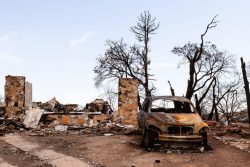Fires wreak havoc and devastation on homes and the lives of homeowners. Unfortunately, preparing for the destruction of a house fire is hard to do for a couple reasons. First, people don’t want to think about losing everything. Second, homeowners often wonder how much it actually helps to prepare for losing everything.
If you wish to collect insurance money to help with your financial recovery, preparation is critical. Fortunately, the preparation is easy. Before diving into how to prepare for a house fire, let’s first look some important items to know about fires.
Statistics on House Fires
The Insurance Information Institute* combines house fire statistics with lightning and debris removal into a single category. According to their figures, this category of loss accounts for fewer than 1% of the homeowners insurance claims. However, in 2015, this category accounted for 45% of the losses for the industry.
Knowing that a house fire can yield total destruction, let’s also look at the most common causes.**
Most Common Causes of a House Fire
- Cooking
- Heating
- Electrical Wiring and Lighting
- Intentional
- Smoking
- Wildfires
House Fire Causes Don’t Tell the Whole Story
While low on the list of causes, smoking and wildfires are top of the list for damage to both people and property. For example, the property damage estimates from the California wildfires in 2017 are more than $4.6 billion. Translated into more meaningful terms, this means nearly 10% of the property losses in 2017 occurred in roughly a two week period in northern California. These figures highlight the tremendous devastation wildfires can cause in a short period of time.
However, the dollar cost of fires doesn’t tell the whole story. When it comes to the human toll, house fires caused by smoking are the number one leading cause of death from home fires. Unfortunately, this is a long-term trend. Smoking has been the leading cause of death from house fires for decades. The typical scenario is a cigarette is dropped onto bedding or upholstered furniture. The bedding or furniture then ignites, catching the house on fire. While smoking is only responsible for 5% of the house fires, these fires claim 22% of the deaths from a house fire and 10% of the injuries.
The following Eight Steps Will Help you Survive a House Fire
Step 1: Keep a Fire Extinguisher Nearby
Having a charged, easily accessible fire extinguisher nearby is common sense. This will help you to contain or put out a fire before the damage is too great.
Step 2: Complete a Home Inventory
Knowing that a house fire can destroy all physical belongings, having a home inventory is the best way to prove both what you had and the value of of your possessions after the fire. No special technology is necessary to complete a home inventory. A complete inventory can be captured in a spreadsheet. Be sure to include receipts, pictures and a description of the item.
Step 3: Avoid Cooking Fires
When cooking, be sure to stay in the kitchen so you can attend to the cooking. Unattended cooking is the leading cause of cooking fires. Frying is greatest risk for causing a cooking fire.
The human toll from fires caused by cooking ranked number one in fire related injuries. The death toll was second, behind smoking and tied with fires caused by heating equipment.
Step 4: Prevent Fires Caused by Heating Equipment
Space heaters, including wood stoves, are the primary cause of heating equipment related home fires. Take care to keep space heaters clean and a safe distance away from flammable items. Central heating systems are less of an issue than space heaters. However, be sure to keep heating systems clean, including the exhaust flue.
When it comes to the human toll, fires started by heating equipment tie for second in deaths. This tie is with fires caused by cooking. In terms of injuries, fires caused by heating equipment are the second leading cause of injuries.
Step 5: Take These Steps to Prevent Electrical Fires
To avoid electrical fires, be sure not to overload circuits. Also, make sure the extension cords are in good condition with no exposed wires. Finally, make sure extension cords are not overloaded.
In terms of the human toll, fires caused by electrical problems are the third leading cause of death by house fire and the fourth leading cause of injuries.
Step 6: Don’t Set Your Home on Fire
This one sounds rather obvious. Believe it or not, intentionally setting the home on fire accounts for 8% of house fires. Surprisingly, this category accounts for 14% of the deaths. According to FBI statistics, 40% of arson arrests in recent years have been people under 18 years of age.
Step 7: Don’t Smoke
Ignoring the negative effects of smoking on your health, smoking has been the number one leading cause of death from a house fire for decades. Clearly, not smoking is beneficial in many ways.
Step 8: Surviving a Wildfire
Always keep brush and trees trimmed back and away from buildings. Also, keep any items that could be fuel to the fire away from the home. When a fire does occur, if authorities suggest you evacuate, follow their recommendations. However, if you get caught in a wildfire, take the following steps:
- Stay calm
- Protect your airways
- Drive out if you can. Be careful of heavy smoke that impairs your vision.
- Head for non-flammable terrain (low-lying, open areas, roads, etc.)
- If possible, immerse yourself in water
House Fire Demographics
The demographics of house fires are important to understand. There are a number of factors worth considering. First, death by house fire is heavily weighted toward people over 50 years old. Other factors that lead to a higher death rate include: not having a high school education, being African American or Native American, being a smoker and being below the poverty level.
Make Sure You Have the Right Insurance Company
Until now, it was hard to know much about insurance companies. Most of the focus on insurance is on the price or some overly technical details about the policy. ValChoice is changing that. You can think of ValChoice as “Big Data for Consumers.”
At ValChoice we believe that anyone required to buy a product or service deserves to know the quality of the service they must buy. Transparency has never before been available for insurance. Technology drives the change that makes transparency possible. Hence, our mission is to provide this much needed information to consumers.
The ValChoice analytics engine grades companies on value, claims handling and service. Get a report on your company so you know how well they measure up agains the competition.
Click the button below to get a report card that compares your insurance company with every other insurance company. With this free report card, you’ll know if it’s time to switch insurance companies. Importantly, we don’t get paid when you buy insurance. That means we won’t encourage you to change companies unless we believe changing is in your best interest.
Note: ValChoice does not receive any form of compensation from insurance companies for grading them in our auto and home insurance reports. Our analysis is independent and unbiased.
*Insurance Information Institute, iii.org.
**National Fire Protection Association, http://www.nfpa.org/News-and-Research/Fire-statistics-and-reports/Fire-statistics/Fire-causes


No comments yet.